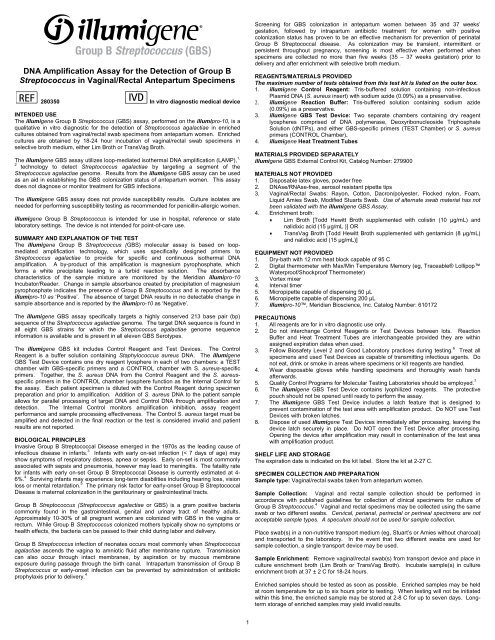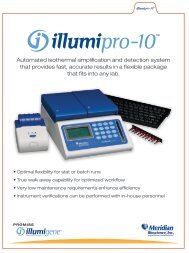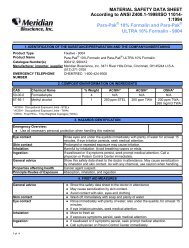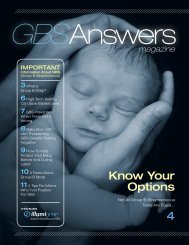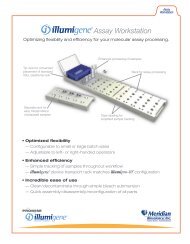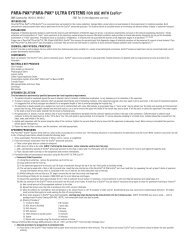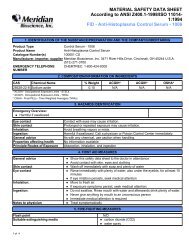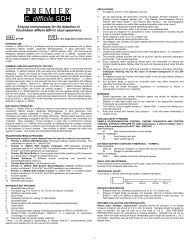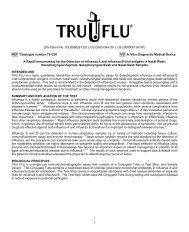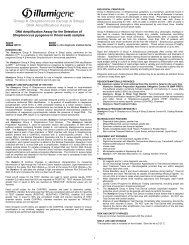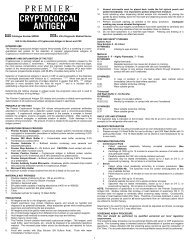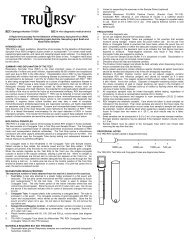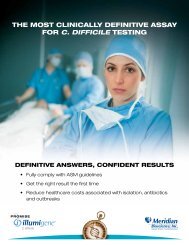DNA Amplification Assay for the Detection of Group B Streptococcus ...
DNA Amplification Assay for the Detection of Group B Streptococcus ...
DNA Amplification Assay for the Detection of Group B Streptococcus ...
Create successful ePaper yourself
Turn your PDF publications into a flip-book with our unique Google optimized e-Paper software.
<strong>DNA</strong> <strong>Amplification</strong> <strong>Assay</strong> <strong>for</strong> <strong>the</strong> <strong>Detection</strong> <strong>of</strong> <strong>Group</strong> B<br />
<strong>Streptococcus</strong> in Vaginal/Rectal Antepartum Specimens<br />
280350 In vitro diagnostic medical device<br />
INTENDED USE<br />
The illumigene <strong>Group</strong> B <strong>Streptococcus</strong> (GBS) assay, per<strong>for</strong>med on <strong>the</strong> illumipro-10, is a<br />
qualitative in vitro diagnostic <strong>for</strong> <strong>the</strong> detection <strong>of</strong> <strong>Streptococcus</strong> agalactiae in enriched<br />
cultures obtained from vaginal/rectal swab specimens from antepartum women. Enriched<br />
cultures are obtained by 18-24 hour incubation <strong>of</strong> vaginal/rectal swab specimens in<br />
selective broth medium, ei<strong>the</strong>r Lim Broth or TransVag Broth.<br />
The illumigene GBS assay utilizes loop-mediated iso<strong>the</strong>rmal <strong>DNA</strong> amplification (LAMP), 1,<br />
2<br />
technology to detect <strong>Streptococcus</strong> agalactiae by targeting a segment <strong>of</strong> <strong>the</strong><br />
<strong>Streptococcus</strong> agalactiae genome. Results from <strong>the</strong> illumigene GBS assay can be used<br />
as an aid in establishing <strong>the</strong> GBS colonization status <strong>of</strong> antepartum women. This assay<br />
does not diagnose or monitor treatment <strong>for</strong> GBS infections.<br />
The illumigene GBS assay does not provide susceptibility results. Culture isolates are<br />
needed <strong>for</strong> per<strong>for</strong>ming susceptibility testing as recommended <strong>for</strong> penicillin-allergic women.<br />
illumigene <strong>Group</strong> B <strong>Streptococcus</strong> is intended <strong>for</strong> use in hospital, reference or state<br />
laboratory settings. The device is not intended <strong>for</strong> point-<strong>of</strong>-care use.<br />
SUMMARY AND EXPLANATION OF THE TEST<br />
The illumigene <strong>Group</strong> B <strong>Streptococcus</strong> (GBS) molecular assay is based on loopmediated<br />
amplification technology, which uses specifically designed primers to<br />
<strong>Streptococcus</strong> agalactiae to provide <strong>for</strong> specific and continuous iso<strong>the</strong>rmal <strong>DNA</strong><br />
amplification. A by-product <strong>of</strong> this amplification is magnesium pyrophosphate, which<br />
<strong>for</strong>ms a white precipitate leading to a turbid reaction solution. The absorbance<br />
characteristics <strong>of</strong> <strong>the</strong> sample mixture are monitored by <strong>the</strong> Meridian illumipro-10<br />
Incubator/Reader. Change in sample absorbance created by precipitation <strong>of</strong> magnesium<br />
pyrophosphate indicates <strong>the</strong> presence <strong>of</strong> <strong>Group</strong> B <strong>Streptococcus</strong> and is reported by <strong>the</strong><br />
illumipro-10 as ‘Positive’. The absence <strong>of</strong> target <strong>DNA</strong> results in no detectable change in<br />
sample absorbance and is reported by <strong>the</strong> illumipro-10 as ‘Negative’.<br />
The illumigene GBS assay specifically targets a highly conserved 213 base pair (bp)<br />
sequence <strong>of</strong> <strong>the</strong> <strong>Streptococcus</strong> agalactiae genome. The target <strong>DNA</strong> sequence is found in<br />
all eight GBS strains <strong>for</strong> which <strong>the</strong> <strong>Streptococcus</strong> agalactiae genome sequence<br />
in<strong>for</strong>mation is available and is present in all eleven GBS Serotypes.<br />
The illumigene GBS kit includes Control Reagent and Test Devices. The Control<br />
Reagent is a buffer solution containing Staphylococcus aureus <strong>DNA</strong>. The illumigene<br />
GBS Test Device contains one dry reagent lyosphere in each <strong>of</strong> two chambers: a TEST<br />
chamber with GBS-specific primers and a CONTROL chamber with S. aureus-specific<br />
primers. Toge<strong>the</strong>r, <strong>the</strong> S. aureus <strong>DNA</strong> from <strong>the</strong> Control Reagent and <strong>the</strong> S. aureusspecific<br />
primers in <strong>the</strong> CONTROL chamber lyosphere function as <strong>the</strong> Internal Control <strong>for</strong><br />
<strong>the</strong> assay. Each patient specimen is diluted with <strong>the</strong> Control Reagent during specimen<br />
preparation and prior to amplification. Addition <strong>of</strong> S. aureus <strong>DNA</strong> to <strong>the</strong> patient sample<br />
allows <strong>for</strong> parallel processing <strong>of</strong> target <strong>DNA</strong> and Control <strong>DNA</strong> through amplification and<br />
detection. The Internal Control monitors amplification inhibition, assay reagent<br />
per<strong>for</strong>mance and sample processing effectiveness. The Control S. aureus target must be<br />
amplified and detected in <strong>the</strong> final reaction or <strong>the</strong> test is considered invalid and patient<br />
results are not reported.<br />
BIOLOGICAL PRINCIPLES<br />
Invasive <strong>Group</strong> B Streptococcal Disease emerged in <strong>the</strong> 1970s as <strong>the</strong> leading cause <strong>of</strong><br />
infectious disease in infants. 3 Infants with early on-set infection (< 7 days <strong>of</strong> age) may<br />
show symptoms <strong>of</strong> respiratory distress, apnea or sepsis. Early on-set is most commonly<br />
associated with sepsis and pneumonia, however may lead to meningitis. The fatality rate<br />
<strong>for</strong> infants with early on-set <strong>Group</strong> B Streptococcal Disease is currently estimated at 4-<br />
6%. 4 Surviving infants may experience long-term disabilities including hearing loss, vision<br />
loss or mental retardation. 5 The primary risk factor <strong>for</strong> early-onset <strong>Group</strong> B Streptococcal<br />
Disease is maternal colonization in <strong>the</strong> genitourinary or gastrointestinal tracts.<br />
<strong>Group</strong> B <strong>Streptococcus</strong> (<strong>Streptococcus</strong> agalactiae or GBS) is a gram positive bacteria<br />
commonly found in <strong>the</strong> gastrointestinal, genital and urinary tract <strong>of</strong> healthy adults.<br />
Approximately 10-30% <strong>of</strong> all pregnant women are colonized with GBS in <strong>the</strong> vagina or<br />
rectum. While <strong>Group</strong> B <strong>Streptococcus</strong> colonized mo<strong>the</strong>rs typically show no symptoms or<br />
health effects, <strong>the</strong> bacteria can be passed to <strong>the</strong>ir child during labor and delivery.<br />
<strong>Group</strong> B <strong>Streptococcus</strong> infection <strong>of</strong> neonates occurs most commonly when <strong>Streptococcus</strong><br />
agalactiae ascends <strong>the</strong> vagina to amniotic fluid after membrane rupture. Transmission<br />
can also occur through intact membranes, by aspiration or by mucous membrane<br />
exposure during passage through <strong>the</strong> birth canal. Intrapartum transmission <strong>of</strong> <strong>Group</strong> B<br />
<strong>Streptococcus</strong> or early-onset infection can be prevented by administration <strong>of</strong> antibiotic<br />
prophylaxis prior to delivery. 4<br />
Screening <strong>for</strong> GBS colonization in antepartum women between 35 and 37 weeks’<br />
gestation, followed by intrapartum antibiotic treatment <strong>for</strong> women with positive<br />
colonization status has proven to be an effective mechanism <strong>for</strong> prevention <strong>of</strong> perinatal<br />
<strong>Group</strong> B Streptococcal disease. As colonization may be transient, intermittent or<br />
persistent throughout pregnancy, screening is most effective when per<strong>for</strong>med when<br />
specimens are collected no more than five weeks (35 – 37 weeks gestation) prior to<br />
delivery and after enrichment with selective broth medium.<br />
REAGENTS/MATERIALS PROVIDED<br />
The maximum number <strong>of</strong> tests obtained from this test kit is listed on <strong>the</strong> outer box.<br />
1. illumigene Control Reagent: Tris-buffered solution containing non-infectious<br />
Plasmid <strong>DNA</strong> (S. aureus insert) with sodium azide (0.09%) as a preservative.<br />
2. illumigene Reaction Buffer: Tris-buffered solution containing sodium azide<br />
(0.09%) as a preservative.<br />
3. illumigene GBS Test Device: Two separate chambers containing dry reagent<br />
lyospheres comprised <strong>of</strong> <strong>DNA</strong> polymerase, Deoxyribonucleoside Triphosphate<br />
Solution (dNTPs), and ei<strong>the</strong>r GBS-specific primers (TEST Chamber) or S. aureus<br />
primers (CONTROL Chamber).<br />
4. illumigene Heat Treatment Tubes<br />
MATERIALS PROVIDED SEPARATELY<br />
illumigene GBS External Control Kit, Catalog Number: 279900<br />
MATERIALS NOT PROVIDED<br />
1. Disposable latex gloves, powder free<br />
2. <strong>DNA</strong>se/RNAse-free, aerosol resistant pipette tips<br />
3. Vaginal/Rectal Swabs: Rayon, Cotton, Dacron/polyester, Flocked nylon, Foam,<br />
Liquid Amies Swab, Modified Stuarts Swab. Use <strong>of</strong> alternate swab material has not<br />
been validated with <strong>the</strong> illumigene GBS <strong>Assay</strong>.<br />
4. Enrichment broth:<br />
Lim Broth [Todd Hewitt Broth supplemented with colistin (10 µg/mL) and<br />
nalidixic acid (15 µg/mL )] OR<br />
TransVag Broth [Todd Hewitt Broth supplemented with gentamicin (8 µg/mL)<br />
and nalidixic acid (15 µg/mL)]<br />
EQUIPMENT NOT PROVIDED<br />
1. Dry-bath with 12 mm heat block capable <strong>of</strong> 95 C<br />
2. Digital <strong>the</strong>rmometer with Max/Min Temperature Memory (eg, Traceable® Lollipop<br />
Waterpro<strong>of</strong>/Shockpro<strong>of</strong> Thermometer)<br />
3. Vortex mixer<br />
4. Interval timer<br />
5. Micropipette capable <strong>of</strong> dispensing 50 μL<br />
6. Micropipette capable <strong>of</strong> dispensing 200 μL<br />
7. iIlumipro-10, Meridian Bioscience, Inc. Catalog Number: 610172<br />
PRECAUTIONS<br />
1. All reagents are <strong>for</strong> in vitro diagnostic use only.<br />
2. Do not interchange Control Reagents or Test Devices between lots. Reaction<br />
Buffer and Heat Treatment Tubes are interchangeable provided <strong>the</strong>y are within<br />
assigned expiration dates when used.<br />
3. Follow Biosafety Level 2 and Good Laboratory practices during testing. 6 Treat all<br />
specimens and used Test Devices as capable <strong>of</strong> transmitting infectious agents. Do<br />
not eat, drink or smoke in areas where specimens or kit reagents are handled.<br />
4. Wear disposable gloves while handling specimens and thoroughly wash hands<br />
afterwards.<br />
5. Quality Control Programs <strong>for</strong> Molecular Testing Laboratories should be employed. 7<br />
6. The illumigene GBS Test Device contains lyophilized reagents. The protective<br />
pouch should not be opened until ready to per<strong>for</strong>m <strong>the</strong> assay.<br />
7. The illumigene GBS Test Device includes a latch feature that is designed to<br />
prevent contamination <strong>of</strong> <strong>the</strong> test area with amplification product. Do NOT use Test<br />
Devices with broken latches.<br />
8. Dispose <strong>of</strong> used illumigene Test Devices immediately after processing, leaving <strong>the</strong><br />
device latch securely in place. Do NOT open <strong>the</strong> Test Device after processing.<br />
Opening <strong>the</strong> device after amplification may result in contamination <strong>of</strong> <strong>the</strong> test area<br />
with amplification product.<br />
SHELF LIFE AND STORAGE<br />
The expiration date is indicated on <strong>the</strong> kit label. Store <strong>the</strong> kit at 2-27 C.<br />
SPECIMEN COLLECTION AND PREPARATION<br />
Sample type: Vaginal/rectal swabs taken from antepartum women.<br />
Sample Collection: Vaginal and rectal sample collection should be per<strong>for</strong>med in<br />
accordance with published guidelines <strong>for</strong> collection <strong>of</strong> clinical specimens <strong>for</strong> culture <strong>of</strong><br />
<strong>Group</strong> B <strong>Streptococcus</strong>. 4 Vaginal and rectal specimens may be collected using <strong>the</strong> same<br />
swab or two different swabs. Cervical, perianal, perirectal or perineal specimens are not<br />
acceptable sample types. A speculum should not be used <strong>for</strong> sample collection.<br />
Place swab(s) in a non-nutritive transport medium (eg, Stuart’s or Amies without charcoal)<br />
and transported to <strong>the</strong> laboratory. In <strong>the</strong> event that two different swabs are used <strong>for</strong><br />
sample collection, a single transport device may be used.<br />
Sample Enrichment: Remove vaginal/rectal swab(s) from transport device and place in<br />
culture enrichment broth (Lim Broth or TransVag Broth). Incubate sample(s) in culture<br />
enrichment broth at 37 ± 2 C <strong>for</strong> 18-24 hours.<br />
Enriched samples should be tested as soon as possible. Enriched samples may be held<br />
at room temperature <strong>for</strong> up to six hours prior to testing. When testing will not be initiated<br />
within this time, <strong>the</strong> enriched sample may be stored at 2-8 C <strong>for</strong> up to seven days. Longterm<br />
storage <strong>of</strong> enriched samples may yield invalid results.<br />
1
REAGENT PREPARATION<br />
Ensure kit reagents are at room temperature (21-27 C) be<strong>for</strong>e use. Incorrect results may<br />
be obtained if reagents are not brought to room temperature prior to use.<br />
SPECIMEN PREPARATION<br />
NOTE: Ensure that <strong>the</strong> illumipro-10 is powered on and required per<strong>for</strong>mance verifications<br />
have been completed prior to initiation <strong>of</strong> SPECIMEN PREPARATION. Refer to <strong>the</strong><br />
illumipro-10 Operator’s Manual <strong>for</strong> fur<strong>the</strong>r in<strong>for</strong>mation regarding instrument set-up and<br />
operation.<br />
1. Label 1 Heat Treatment Tube <strong>for</strong> each sample to be tested.<br />
2. Add 200 µL <strong>of</strong> <strong>the</strong> illumigene Control Reagent to each heat treatment tube.<br />
3. Mix each enriched broth culture thoroughly.<br />
4. Add 50 µL <strong>of</strong> <strong>the</strong> mixed, enriched broth liquid to <strong>the</strong> illumigene Control Reagent.<br />
Specimens diluted in illumigene Control Reagent may be held at room temperature<br />
(21-27 C) <strong>for</strong> up to 15 minutes prior to proceeding. Incorrect results may be<br />
obtained if diluted specimens are held longer than 15 minutes be<strong>for</strong>e heat<br />
treatment.<br />
5. Vortex each Sample/Control mixture <strong>for</strong> a minimum <strong>of</strong> 10 seconds.<br />
6. Heat each Sample/Control mixture in a dry-bath/heat block at 95 ± 5 C <strong>for</strong> 10 ± 2<br />
minutes. Monitor heat-treatment step with digital <strong>the</strong>rmometer and interval timer.<br />
7. Remove each Heat Treatment Tube from <strong>the</strong> dry-bath/heat block and vortex <strong>for</strong><br />
approximately 10 seconds. Heat-treated samples may be held at 19-29 C <strong>for</strong> up to<br />
45 minutes prior to addition to Reaction Buffer. Heat-treated samples may not be<br />
frozen.<br />
TEST PROCEDURE<br />
NOTE: A maximum <strong>of</strong> 10 samples can be processed in a single illumipro-10 run.<br />
1. Transfer 50 µL <strong>of</strong> heat-treated sample to an appropriately labeled illumigene<br />
Reaction Buffer tube.<br />
2. Vortex <strong>the</strong> Reaction Buffer tube containing heat-treated sample <strong>for</strong> approximately<br />
10 seconds.<br />
3. Repeat steps 1 and 2 <strong>for</strong> all <strong>the</strong> samples to be analyzed be<strong>for</strong>e proceeding.<br />
4. Remove 1 illumigene GBS Test Device from its protective pouch per sample.<br />
Carefully open <strong>the</strong> device, holding <strong>the</strong> chambers such that <strong>the</strong> lyophilized reagent<br />
will not fall out upon opening. Place device on a flat surface or in a rack that can<br />
accommodate <strong>the</strong> device.<br />
5. Using a new pipette tip, transfer 50 µL from <strong>the</strong> Reaction Buffer tube containing<br />
heat-treated sample to <strong>the</strong> TEST chamber (White Bead) <strong>of</strong> <strong>the</strong> illumigene Test<br />
Device. Do not introduce air bubbles. Using a new pipette tip, transfer 50 µL from<br />
<strong>the</strong> Reaction Buffer tube containing heat-treated sample to <strong>the</strong> CONTROL chamber<br />
(Yellow Bead) <strong>of</strong> <strong>the</strong> illumigene Test Device. Do not introduce air bubbles. Close<br />
<strong>the</strong> illumigene Test Device and fasten <strong>the</strong> latch securely.<br />
6. Tap device on <strong>the</strong> bench top or mix to remove air bubbles. Carefully examine <strong>the</strong><br />
test device to ensure that <strong>the</strong>re are no air bubbles left in <strong>the</strong> tube and no liquid<br />
remaining in <strong>the</strong> top <strong>of</strong> <strong>the</strong> device.<br />
7. Insert <strong>the</strong> illumigene Test Device into <strong>the</strong> illumipro-10 and initiate amplification<br />
reaction and detection. Results will be displayed at <strong>the</strong> conclusion <strong>of</strong> <strong>the</strong> run.<br />
INTERPRETATION OF RESULTS<br />
Sample ID Reported Result Interpretation<br />
Patient<br />
Specimen<br />
Positive Control<br />
Negative Control<br />
EMPTY WELL<br />
POSITIVE<br />
NEGATIVE<br />
INVALID<br />
POSITIVE<br />
NEGATIVE<br />
INVALID<br />
POSITIVE<br />
NEGATIVE<br />
INVALID<br />
NONE<br />
Sample contains <strong>Streptococcus</strong> agalactiae target <strong>DNA</strong>.<br />
No <strong>Streptococcus</strong> agalactiae <strong>DNA</strong> detected.<br />
No reportable result. Repeat <strong>the</strong> test using <strong>the</strong><br />
original enriched broth sample.<br />
Inhibitory patient specimen, improper sample<br />
preparation, reagent failure, instrument failure or internal<br />
control failure.<br />
Valid positive control result. Reagents active at time <strong>of</strong><br />
use, illumipro-10 per<strong>for</strong>ming correctly.<br />
Incorrect control result. Repeat control testing as <strong>the</strong><br />
first step in determining <strong>the</strong> root cause <strong>of</strong> <strong>the</strong> failure. If<br />
control failures are repeated please contact Meridian’s<br />
Technical Services at 1-800-343-3858 (US) or your local<br />
distributor.<br />
No reportable result. Repeat entire assay run using<br />
original samples.<br />
Improper sample preparation, reagent failure, instrument<br />
failure or internal control failure.<br />
Incorrect control result. Repeat control testing as <strong>the</strong><br />
first step in determining <strong>the</strong> root cause <strong>of</strong> <strong>the</strong> failure. If<br />
control failures are repeated please contact Meridian’s<br />
Technical Services at 1-800-343-3858 (US) or your local<br />
distributor.<br />
Valid negative control result. Reagents active at time <strong>of</strong><br />
use, illumipro-10 per<strong>for</strong>ming correctly.<br />
No reportable result. Repeat entire assay run using<br />
original samples.<br />
Improper sample preparation, reagent failure, instrument<br />
failure or internal control failure.<br />
No illumigene Test Device in <strong>the</strong> illumipro-10 Well.<br />
OR<br />
The illumigene Test Device present is compromised due<br />
to sample preparation failure, dirty device or improperly<br />
seated device. Repeat <strong>the</strong> test using original sample.<br />
QUALITY CONTROL<br />
This test should be per<strong>for</strong>med per applicable local, state, or federal regulations or<br />
accrediting agencies.<br />
1. Each device contains an internal control chamber that controls <strong>for</strong> amplification<br />
inhibition, assay reagents and sample processing effectiveness.<br />
2. The heat-treatment step is monitored with an external <strong>the</strong>rmometer and interval<br />
timer. Use <strong>the</strong> max/min temperature memory <strong>of</strong> <strong>the</strong> <strong>the</strong>rmometer to ensure that a<br />
temperature <strong>of</strong> 95 ± 5 C is maintained. Use <strong>the</strong> interval timer to ensure that heattreatment<br />
duration is 10 ± 2 minutes.<br />
3. Good laboratory practice recommends <strong>the</strong> use <strong>of</strong> control materials. Users should<br />
follow <strong>the</strong> appropriate federal, state and local guidelines concerning <strong>the</strong> running <strong>of</strong><br />
external quality controls.<br />
4. illumigene GBS External Control Reagents are supplied separately (Catalog<br />
279900). It is recommended that <strong>the</strong> reactivity <strong>of</strong> each new lot and each new<br />
shipment <strong>of</strong> illumigene GBS be verified on receipt and be<strong>for</strong>e use. External control<br />
tests should be per<strong>for</strong>med <strong>the</strong>reafter in accordance with appropriate federal, state<br />
and local guidelines. The illumigene GBS test kit should not be used in patient<br />
testing if <strong>the</strong> external controls do not produce <strong>the</strong> correct results.<br />
5. A separate device must be used <strong>for</strong> each external control reagent.<br />
6. Heat-treatment <strong>of</strong> GBS External Positive or Negative Control samples is not<br />
required.<br />
EXPECTED VALUES<br />
Approximately 10-30% <strong>of</strong> antepartum women are colonized with <strong>Group</strong> B <strong>Streptococcus</strong><br />
in <strong>the</strong> vagina or rectum. 4 The overall incidence <strong>of</strong> GBS colonization in antepartum women<br />
tested during this study was 24.3% (201 <strong>of</strong> 826). Incidence <strong>of</strong> GBS colonization <strong>for</strong><br />
enrichment per<strong>for</strong>med using Lim Broth was found to be 25.1% (101 <strong>of</strong> 403); while<br />
incidence <strong>for</strong> specimens enriched by TransVag Broth was found to be 23.6% (100 <strong>of</strong> 423).<br />
LIMITATIONS OF THE PROCEDURE<br />
1. The illumigene GBS assay does not distinguish between viable and non-viable<br />
organisms.<br />
2. The illumigene GBS assay is <strong>for</strong> use with vaginal/rectal swab specimens collected<br />
in accordance with established guidelines <strong>for</strong> collection <strong>of</strong> <strong>Group</strong> B <strong>Streptococcus</strong><br />
culture specimens. Cervical, perianal, perirectal or perineal specimens are not<br />
acceptable sample types. A speculum should not be used <strong>for</strong> sample collection.<br />
3. The illumigene GBS assay does not provide susceptibility results. Culture isolates<br />
are needed <strong>for</strong> per<strong>for</strong>ming susceptibility testing as recommended <strong>for</strong> penicillinallergic<br />
women.<br />
4. GBS colonization during pregnancy can be intermittent, persistent or transient. The<br />
clinical utility <strong>of</strong> GBS screening decreases when testing is per<strong>for</strong>med more than five<br />
weeks prior to delivery.<br />
5. Evaluation <strong>of</strong> non-hemolytic colonies was not per<strong>for</strong>med as part <strong>of</strong> Clinical Site<br />
testing.<br />
6. Crossreactivity with Enterococcus dispar was observed during per<strong>for</strong>mance<br />
characteristic testing. Negative Lim Broth specimens inoculated with Enterococcus<br />
dispar at a final concentration <strong>of</strong> 1.2 x 10 8 CFU/mL produced positive results <strong>for</strong> one<br />
<strong>of</strong> seven replicates tested.<br />
SPECIFIC PERFORMANCE CHARACTERISTICS<br />
illumigene GBS was evaluated in 2011 by four independent clinical test sites located in<br />
<strong>the</strong> Midwestern and Sou<strong>the</strong>rn regions <strong>of</strong> <strong>the</strong> United States. Overall per<strong>for</strong>mance<br />
in<strong>for</strong>mation is shown in Table 1.<br />
Table 1. Overall per<strong>for</strong>mance data<br />
<strong>Group</strong> B <strong>Streptococcus</strong><br />
Culture<br />
illumigene <strong>Group</strong> B <strong>Streptococcus</strong> (GBS)<br />
Positive Negative Total<br />
Positive 150 4 154<br />
Negative 51 610 661<br />
Total 201 614 815<br />
95% CI<br />
Sensitivity 150/154 97.4% 91.9 – 99.0%<br />
Specificity 610/661 92.3% 90.0 – 94.1%<br />
Correlation 760/815 93.3% 91.3 – 94.8%<br />
Forty-eight <strong>of</strong> <strong>the</strong> 51 false positive results were positive by ano<strong>the</strong>r molecular method.<br />
Invalid results were obtained <strong>for</strong> 11/826 samples tested or 1.3%. Two <strong>of</strong> <strong>the</strong> 11 samples<br />
remained invalid after repeat testing <strong>of</strong> <strong>the</strong> original sample.<br />
A total <strong>of</strong> 826 qualified patient samples were evaluated. Samples were obtained<br />
according to established guidelines <strong>for</strong> collection <strong>of</strong> clinical specimens <strong>for</strong> culture <strong>of</strong> <strong>Group</strong><br />
B <strong>Streptococcus</strong> and enriched <strong>for</strong> 18-24 hours in ei<strong>the</strong>r Lim Broth or TransVag Broth. A<br />
total 403 (48.8%) Lim Broth enriched specimens were tested by Clinical Site 2 (210) and<br />
Clinical Site 4 (193). A total <strong>of</strong> 423 (51.2%) TransVag Broth enriched specimens were<br />
tested by Clinical Site 1 (234) and Clinical Site 3 (189). The age groups <strong>of</strong> patients tested<br />
ranged from 15 years <strong>of</strong> age to 44 years <strong>of</strong> age, with age unknown <strong>for</strong> 3 (0.4%) <strong>of</strong> <strong>the</strong><br />
patient population. No differences in test per<strong>for</strong>mance were observed based on<br />
enrichment medium or patient age. Table 2 shows assay per<strong>for</strong>mance by enrichment<br />
medium; Table 3 summarizes assay per<strong>for</strong>mance by Clinical Site.<br />
Table 2. Per<strong>for</strong>mance characteristics by enrichment method<br />
illumigene /<br />
GBS Culture<br />
Positive Samples<br />
Sensitivity<br />
%<br />
95% CI<br />
illumigene /<br />
GBS Culture<br />
Negative Samples<br />
Specificity<br />
%<br />
95% CI<br />
Total 150/154 97.4% 91.9 – 99.0% 610/661 92.3% 90.0 – 94.1%<br />
Lim Broth 82/84 97.6% 91.7 – 99.3% 296/315 94.0% 90.8 – 96.1%<br />
TransVag<br />
Broth<br />
68/70 97.1% 90.2 – 99.2% 314/346 90.8% 87.2 – 93.4%<br />
2
Table 3. Per<strong>for</strong>mance characteristics by clinical site<br />
Site<br />
illumigene /<br />
GBS Culture<br />
Positive Samples<br />
Sensitivity<br />
%<br />
95% CI<br />
illumigene /<br />
GBS Culture<br />
Negative Samples<br />
Specificity<br />
%<br />
95% CI<br />
Total 150/154 97.4% 91.9 – 99.0% 610/661 92.3% 90.0 – 94.1%<br />
Site 1 32/33 97.0% 84.7 – 99.5% 197/199 99.0% 96.4 – 99.7%<br />
Site 2 38/39 97.4% 86.8 – 99.5% 162/168 96.4% 92.4 – 98.4%<br />
Site 3 36/37 97.3% 86.2 – 99.5% 117/147 79.6% 72.4 – 85.3%<br />
Site 4 44/45 97.8% 88.4 – 99.6% 134/147 97.8% 85.5 – 94.8%<br />
ANALYTICAL SENSITIVITY<br />
The analytical sensitivity or Limit <strong>of</strong> Detect <strong>for</strong> <strong>the</strong> illumigene <strong>Group</strong> B <strong>Streptococcus</strong><br />
(GBS) assay was determined <strong>for</strong> all common S. agalactiae strains and serotypes.<br />
Limit <strong>of</strong> Detect was determined following Lim Broth enrichment, using a minimum <strong>of</strong> 20<br />
replicates <strong>for</strong> each measurand and a stated probability (eg. 95% where 19/20 replicates<br />
are positive) <strong>of</strong> obtaining positive responses. Analytical sensitivity testing is summarized<br />
below:<br />
Serotype <strong>Streptococcus</strong> agalactiae Strain Description CFU/Test<br />
Ia NCTC 11248 60<br />
Ib ATCC 12401 80<br />
Ic NCTC 11253 640<br />
II II/2 320<br />
III ATCC 12403 160<br />
V ATCC BAA-611 1280<br />
ASSAY REACTIVITY<br />
The following S. agalactiae strains were tested and produced positive reactions at 1280<br />
CFU/test with illumigene GBS: NCTC 11930 (Serotype IV), NCTC 08188 (Serotype VIa),<br />
VII/2 (Serotype VII), VIII/2 (Serotype VIII), NCTC 11249 (Serotype X); ATCC 13813 and<br />
ATCC 12386.<br />
REPRODUCIBILITY<br />
Blind coded panels <strong>of</strong> 10 samples were supplied to three independent laboratories <strong>for</strong><br />
reproducibility studies. Samples were randomly sorted within each panel to mask sample<br />
identities. The panels included contrived samples manufactured as low positive samples<br />
(ie. near <strong>the</strong> assay limit <strong>of</strong> detection, n = 3) and high negative samples, (n = 3). The<br />
panels also included contrived positive (n = 3) samples and natural negative samples (n =<br />
1). Testing was per<strong>for</strong>med by different operators at each site on <strong>the</strong> same day (intraassay<br />
variability) <strong>for</strong> five days (inter-assay variability). Three lots <strong>of</strong> illumigene GBS and<br />
five illumipro-10 instruments were used in this study. Positive and Negative Controls<br />
were tested each day <strong>of</strong> testing. The results are given in <strong>the</strong> table below:<br />
Sample<br />
Type<br />
Clinical Site 1 Clinical Site 2 Clinical Site 4 Total<br />
Percent<br />
agreement<br />
Percent<br />
agreement<br />
Percent<br />
agreement<br />
Percent<br />
agreement<br />
Negative 10/10 100% 10/10 100% 10/10 100% 10/10 100%<br />
High<br />
Negative<br />
30/30 100% 30/30 100% 30/30 100% 30/30 100%<br />
Low Positive 30/30 100% 30/30 100% 30/30 100% 30/30 100%<br />
Positive 30/30 100% 30/30 100% 30/30 100% 30/30 100%<br />
Negative<br />
Control<br />
Positive<br />
Control<br />
10/10 100% 10/10 100% 10/10 100% 10/10 100%<br />
10/10 100% 10/10 100% 10/10 100% 10/10 100%<br />
CROSSREACTIVITY STUDIES<br />
Crossreactivity studies were per<strong>for</strong>med with positive and negative Lim Broth specimens<br />
inoculated with bacterial or fungal organisms to a final concentration <strong>of</strong> 1.2 x 10 8 CFU/mL<br />
or virus at a minimum <strong>of</strong> 1 x 10 5 TCID 50/mL. Crossreactivity with Enterococcus dispar<br />
was observed in one <strong>of</strong> seven replicates tested. None <strong>of</strong> <strong>the</strong> following organisms reacted<br />
with illumigene GBS:<br />
Aeromonas hydrophila, Alcaligenes faecalis, Bacillus cereus, Bacillus subtilis, Bacteroides<br />
fragilis, Campylobacter coli, Campylobacter fetus, Campylobacter jejuni, Candida<br />
albicans, Candida glabrata, Candida krusei, Candida parapsilosis, Candida tropicalis,<br />
Citrobacter freundii, Clostridium bifermentans, Clostridium butyricum, Clostridium difficile,<br />
Clostridium histolyticum, Clostridium novyi, Clostridium perfringens, Clostridium septicum,<br />
Clostridium sordellii, Clostridium sporogenes, Clostridium tetani, Corynebacterium<br />
genitalium, Corynebacterium urealyticum, Corynebacterium xerosis, Enterobacter<br />
aerogenes, Enterobacter cloacae, Enterococcus avium, Enterococcus durans,<br />
Enterococcus faecalis, Enterococcus faecium, Escherichia coli, Escherichia coli O157:H7,<br />
Escherichia fergusonii, Escherichia hermannii, Gardnerella vaginalis, Haemophilus<br />
ducreyi, Helicobacter pylori, Klebsiella pneumoniae, Lactobacillus acidophilus,<br />
Lactobacillus brevis, Lactobacillus casei, Lactobacillus delbruekii subspecies lactis,<br />
Lactobacillus jensenii, Lactococcus lactis, Legionella pneumophila, Listeria<br />
monocytogenes, Moraxella osloensis, Morganella morganii, Neisseria gonorrhoeae,<br />
Peptostreptococcus anaerobius, Plesiomonas shigelloides, Porphyromonas<br />
asaccharolytica, Prevotella melaninogenica, Propionibacterium acnes, Proteus mirabilis,<br />
Proteus vulgaris, Pseudomonas aeruginosa, Pseudomonus fluorescens, Salmonella<br />
<strong>Group</strong> B, Salmonella <strong>Group</strong> C, Salmonella <strong>Group</strong> D, Salmonella <strong>Group</strong> E, Serratia<br />
liquefaciens, Serratia marcescens, Shigella boydii, Shigella flexneri, Shigella sonnei,<br />
Staphylococcus aureus, Staphylococcus aureus (Cowan), Staphylococcus epidermidis,<br />
Staphylococcus saprophyticus, <strong>Streptococcus</strong> anginosus, <strong>Streptococcus</strong> bovis,<br />
<strong>Streptococcus</strong> dysgalactiae equisimilis, <strong>Streptococcus</strong> intermedius, <strong>Streptococcus</strong> mitis,<br />
<strong>Streptococcus</strong> oralis, <strong>Streptococcus</strong> pneumoniae, <strong>Streptococcus</strong> pyogenes,<br />
<strong>Streptococcus</strong> salivarius, <strong>Streptococcus</strong> sanguinis, Vibrio parahaemolyticus, Yersinia<br />
enterocolitica, Adenovirus 40, Adenovirus 41, BK virus, Coxsackievirus, Echovirus,<br />
Epstein Barr virus, Herpes simplex virus-1, Herpes simplex virus-2, Rotavirus.<br />
Mycoplasma genitalium, Mycoplasma hominis and Ureaplasma urealyticum were tested<br />
at final concentrations ranging between 1.6 x 10 6 and 9.9 x 10 6 CFU/mL with no reaction<br />
with <strong>the</strong> illumigene GBS assay.<br />
TESTS FOR INTERFERING SUBSTANCES<br />
The following substances, at <strong>the</strong> specified saturated solvent/diluent concentrations, do not<br />
interfere with test results: Amniotic fluid (10% v/v), Human <strong>DNA</strong> (100 ng/Test), Urine (30%<br />
v/v), Whole Blood (2.5% v/v). Whole Blood at concentrations greater than 2.5% v/v<br />
interferes with <strong>the</strong> illumigene GBS assay.<br />
Additional testing was per<strong>for</strong>med by coating cotton swabs with potentially interfering<br />
substances. Coated swabs were combined with Lim Broth sample and processed<br />
through <strong>the</strong> illumigene GBS assay. The following substances do not interfere with test<br />
results: Meconium, Stool, Hemorrhoidal cream (30.65 mg/100 mg), Miconazole<br />
(fungicide), Mucin (0.5-1.5%), Spermicidal gel (nonoxynol 9) (4 mg/100 mg). Lubricating<br />
gel produced False Negative Results in one <strong>of</strong> 11 replicates tested. Body Powder<br />
produced False Negative Results in one <strong>of</strong> 10 replicates tested.<br />
REFERENCES<br />
1. Nagamine, K., Hase, T., Notoni, T. Accelerated reaction by loop-mediated<br />
iso<strong>the</strong>rmal amplifications using loop primers. Mol Cell Probes 2002;16:223-29.<br />
2. Mori, Y., Kitao, M., Tomita, N., Notoni, T. Real-time turbidimetry <strong>of</strong> LAMP reaction<br />
<strong>for</strong> quantitating template <strong>DNA</strong>. J Biochem Biophys 2004;59:145-47.<br />
3. Van Dyke, M., et al. Evaluation <strong>of</strong> Universal Antenatal Screening <strong>for</strong> <strong>Group</strong> B<br />
<strong>Streptococcus</strong>. N Engl J Med 2009; 360:2626-36.<br />
4. Department <strong>of</strong> Health and Human Services, Centers <strong>for</strong> Disease Control and<br />
Prevention. Prevention <strong>of</strong> Perinatal <strong>Group</strong> B Streptococcal Disease, Revised<br />
Guidelines from CDC, 2010. MMWR 2010;59<br />
5. Schrag, S., et al. A Population-Based Comparison <strong>of</strong> Strategies to Prevent Early-<br />
Onset <strong>Group</strong> B Streptococcal Disease in Neonates. N Engl J Med 2002;347: 233-<br />
239.<br />
6. US Department <strong>of</strong> Health and Human Services PHS/CDC/NIH. Biosafety in<br />
microbiology and biomedical laboratories, Washington DC: US Government Printing<br />
Office, 2007.<br />
7. CLSI: MM3-A2 Molecular diagnostic methods <strong>for</strong> infectious disease; approved<br />
guideline, 2nd ed. Wayne PA: Clinical Laboratory Standards Institute. 2006.<br />
SN11181 REV. 11/11<br />
3
INTERNATIONAL SYMBOL USAGE<br />
You may see one or more <strong>of</strong> <strong>the</strong>se symbols on <strong>the</strong> labeling/packaging <strong>of</strong> this product:<br />
Key guide to symbols (Guida ai simboli, Guide des symbols, Guia de simbolos,<br />
Erläuterung der gaphischen symbole)<br />
For technical assistance, call Technical Support Services at 800-343-3858 between <strong>the</strong><br />
hours <strong>of</strong> 8AM and 6PM, USA Eastern Standard Time. To place an order, call Customer<br />
Service Department at 800-543-1980.<br />
4


